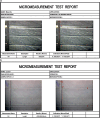Assessment of dimensional stability of novel VPES impression material at different time intervals with standard disinfectants
- PMID: 38762747
- PMCID: PMC11102608
- DOI: 10.1186/s12903-024-04323-5
Assessment of dimensional stability of novel VPES impression material at different time intervals with standard disinfectants
Abstract
Background: Vinyl polyether silicone (VPES) is a novel impression biomaterial made of a combination of vinyl polysiloxane (VPS) and polyether (PE). Thus, it is significant to assess its properties and behaviour under varied disinfectant test conditions. This study aimed to assess the dimensional stability of novel VPES impression material after immersion in standard disinfectants for different time intervals.
Methods: Elastomeric impression material used -medium body regular set (Monophase) [Exa'lence GC America]. A total of 84 Specimens were fabricated using stainless steel die and ring (ADA specification 19). These samples were distributed into a control group (n=12) and a test group (n=72). The test group was divided into 3 groups, based on the type of disinfectant used - Group-A- 2% Glutaraldehyde, Group-B- 0. 5% Sodium hypochlorite and Group-C- 2% Chlorhexidine each test group was further divided into 2 subgroups (n=12/subgroup) based on time intervals for which each sample was immersed in the disinfectants - subgroup-1- 10 mins and Subgroup 2- 30 mins. After the impression material was set, it was removed from the ring and then it was washed in water for 15 seconds. Control group measurements were made immediately on a stereomicroscope and other samples were immersed in the three disinfection solutions for 10 mins and 30 mins to check the dimensional stability by measuring the distance between the lines generated by the stainless steel die on the samples using a stereomicroscope at x40 magnification.
Results: The distance measured in the control group was 4397.2078 µm and 4396.1571 µm; for the test group Group-A- 2% Glutaraldehyde was 4396.4075 µm and 4394.5992 µm; Group-B- 0. 5% Sodium hypochlorite was 4394.5453 µm and 4389.4711 µm Group-C- 2% Chlorhexidine was 4395.2953 µm and 4387.1703 µm respectively for 10 mins and 30 mins. Percentage dimensional change was in the range of 0.02 - 0.25 for all the groups for 10 mins and 30 mins.
Conclusions: 2 % Glutaraldehyde is the most suitable disinfectant for VPES elastomeric impression material in terms of dimensional stability and shows minimum dimensional changes as compared to that of 2% Chlorhexidine and 0.5% Sodium hypochlorite.
Keywords: Biomaterials; Biotechnology; Dental materials; Glutaraldehyde; In-vitro study; Novel materials; Sodium hypochlorite; Vinyl polyether silicone (VPES).
© 2024. The Author(s).
Conflict of interest statement
The authors declare no competing interests.
Figures







Similar articles
-
An in vitro study on the dimensional stability of a vinyl polyether silicone impression material over a prolonged storage period.J Prosthet Dent. 2013 Mar;109(3):172-8. doi: 10.1016/S0022-3913(13)60038-4. J Prosthet Dent. 2013. PMID: 23522366
-
Surface Detail Reproduction and Effect of Disinfectant and Long-Term Storage on the Dimensional Stability of a Novel Vinyl Polyether Silicone Impression Material.J Prosthodont. 2015 Aug;24(6):494-8. doi: 10.1111/jopr.12244. Epub 2014 Dec 17. J Prosthodont. 2015. PMID: 25522249
-
3D evaluation of the effect of disinfectants on dimensional accuracy and stability of two elastomeric impression materials.Dent Mater J. 2018 Jul 29;37(4):675-684. doi: 10.4012/dmj.2017-097. Epub 2018 May 31. Dent Mater J. 2018. PMID: 29848853
-
Effect of chemical disinfection on the dimensional stability of polyvinyl ether siloxane impression material: a systemic review and meta-analysis.BMC Oral Health. 2023 Jul 10;23(1):471. doi: 10.1186/s12903-023-03168-8. BMC Oral Health. 2023. PMID: 37430254 Free PMC article.
-
Disinfection efficacy of sodium hypochlorite and glutaraldehyde and their effects on the dimensional stability and surface properties of dental impressions: a systematic review.PeerJ. 2023 Feb 20;11:e14868. doi: 10.7717/peerj.14868. eCollection 2023. PeerJ. 2023. PMID: 36846444 Free PMC article.
Cited by
-
Dimensional Accuracy of Novel Vinyl Polysiloxane Compared with Polyether Impression Materials: An In Vitro Study.Materials (Basel). 2024 Aug 27;17(17):4221. doi: 10.3390/ma17174221. Materials (Basel). 2024. PMID: 39274611 Free PMC article.
References
-
- Nassar U, Oko A, Adeeb S, El-Rich M, Flores-Mir C. An in vitro study on the dimensional stability of a vinyl polyether silicone impression material over a prolonged storage period. J Prosthet Dentist. 2013;109. 10.1016/S0022-3913(13)60038-4. - PubMed
-
- Nassar U, Chow AK. Surface Detail Reproduction and Effect of Disinfectant and Long-Term Storage on the Dimensional Stability of a Novel Vinyl Polyether Silicone Impression Material. J Prosthodont. 2015;24. 10.1111/jopr.12244. - PubMed
-
- Tamilselvi S, Nagate RR, Al-Ahmari MMM, Kokila G, Tikare S, Chaturvedi S. Comparison of the effect of sodium bicarbonate and glycine air polishing systems on tooth surface roughness: an atomic force microscopic analysis. Technol Health Care. 2021;29. 10.3233/THC-202210. - PubMed
-
- Alsubaiy EF, Chaturvedi S, Qutub OA, Mously HA, Zarbah MA, Haralur SB, et al. Novel CAD-CAM zirconia coping design to enhance the aesthetics and strength for anterior PLZ crowns. Technol Health Care. 2021;29. 10.3233/THC-202782. - PubMed
MeSH terms
Substances
Grants and funding
LinkOut - more resources
Full Text Sources
Research Materials
Miscellaneous

